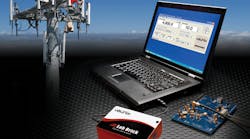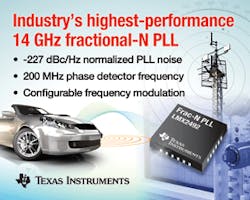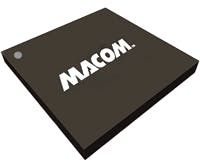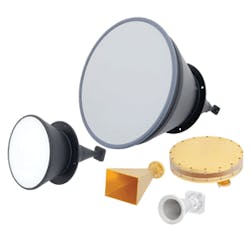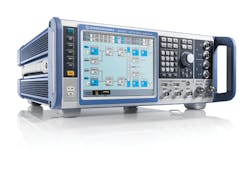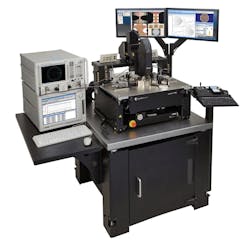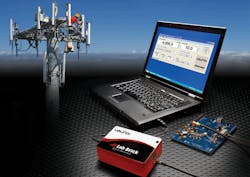This file type includes high resolution graphics and schematics when applicable.
Microwave Week, as it was billed by the IEEE this past June 1-6 in Tampa, Fla., turned out to be more than just time on the beach and a mid-year break from the factory. This year’s Microwave Theory & Techniques Society (MTT-S) International Microwave Symposium (IMS 2014) was a well-attended conference and exhibition, with more than 150 technical presentations and demonstrations, and more than 550 exhibition booths for visitors to sample the newest RF/microwave offerings.
As it is year after year, the exhibition floor was truly an opportunity for RF/microwave specifiers to learn about existing and new products at every level, from tiny devices to massive systems. Perhaps even more invaluable than the opportunity to see the products was the chance to meet many of the engineers behind them, picking their brains for modifications, enhancements, and improvements.
For those in need of increased functionality in smaller-sized packages, and to generate clean output signals, IMS 2014 offered the opportunity to collect data on some tremendous offerings in new integrated-circuit (IC) products. Among these were the model LMX2492 14-GHz fractional-N Platinum phased-locked-loop (PLL) IC from Texas Instruments. This device (Fig. 1) supports a 200-MHz phase frequency detector, a 5-V charge pump supply, and an operating frequency range of 0.5 to 14.0 GHz. The company offered the IC and guidance on its use in Tampa.
Available in industrial and automotive grade packaging, in a 24-pin, 4-×-4 mm WQFN housing, the PLL exhibits a phase-noise floor of -227 dBc/Hz in support of low-noise local oscillators (LOs) for enhanced receiver sensitivity. The wide modulation bandwidth enables flexible frequency and phase modulation, including linear frequency modulation (FM), frequency-shift-keying (FSK) modulation, and phase-shift-keying (PSK) modulation.
With the aid of Texas Instruments’ WEBENCH Clock Architect software (which features more than 40,000 component models from suppliers in addition to Texas Instruments), engineers can simulate different oscillators and timing schemes. The software includes a PLL loop-filter design section that allows optimization of phase noise and jitter for different oscillator designs. The company also had its model LMX2492EVM evaluation module (EVM) on display at the exhibition, to show designers a quick and easy way to get started designing oscillator and synthesizer circuits with the LMX2492.
Also at IMS 2014 to help exhibition visitors achieve precise signal generation, CTS Corp. showed off its model 149 oven-controlled crystal oscillator (OCXO) from subsidiary CTS Electronic Components, Inc. Designed for high stability in a miniature package, the OCXO was being offered in frequencies from 10 to 25 MHz with stability as tight as ±50 ppb for a wide temperature range of -40 to +85°C. This type of oscillator, with phase noise of only -152 dBc/Hz offset 100 kHz from the carrier, would normally be considerably larger than the circuit in this package, which measures only 9 × 14 mm.
But many of the visitors to the CTS booth might even have questioned whether this was truly an oven-controlled oscillator in that small package, until they saw the stability performance. The bonus is that at room temperature (+25°C), this tiny oscillator consumes less than 1 W of power from a +3.3 or +5.0 VDC voltage supply.
One of several trends among component suppliers at IMS 2014 was the growing availability of millimeter-wave products, notably for areas of interest like line-of-sight communications links and automotive radar systems. For example, MACOM Technology Solutions unveiled its broadband model MAAP-011106 power amplifier (PA), designed for use at E-band frequencies from 71 to 86 GHz (Fig. 2). Suited for use in small-cell wireless backhaul equipment, the E-band amplifier supports wireless data rates to 1 Gb/s and higher at those frequencies with saturated output-power levels of +25.5 dBm in the standard 71-to-76-GHz and 81-to-86-GHz millimeter-wave communications bands normally handled by two separate amplifiers.
The E-band PA is based on GaAs pseudomorphic-high-electron-mobility-transistor (pHEMT) monolithic-microwave-integrated-circuit (MMIC) semiconductor technology. It features an integrated power detector and provides 20-dB small-signal gain with variable gain control for flexible performance tuning. The amplifier is rated for saturated output power of +25 dBm from 71 to 86 GHz, with an output third-order intercept point (OIP3) of +30 dBm or more.
Skyworks Solutions made noise at the 2014 IMS for its lack of noise—or more specifically, a number of new low-noise amplifiers (LNAs) with impressive noise-figure performance. As examples, amplifier models SKY67150-396LF and SKY67153-396LF were designed and optimized for applications from 300 to 2200 MHz and from 700 to 3800 MHz, respectively, with healthy small-signal gain and extremely low noise figures. Suitable for controlling noise in receivers (especially in commercial wireless communications systems), the amplifiers take advantage of a GaAs pHEMT semiconductor process and proven packaging methods to do away with noise.
Supplied in a 2-×-2 mm, 8-pin dual flat no lead (DFN) package, model SKY67150-396LF operates from 300 to 2200 MHz and achieves a typical minimum noise figure of just 0.23 dB when tested in the firm’s evaluation board at 849 MHz; the maximum noise figure is 0.38 dB at that test frequency and in the evaluation board. For additional measurements referenced to a test frequency of 849 MHz in the evaluation board, the LNA provides 19.0 dB minimum small-signal gain and 20.5 dB typical small-signal gain, with typical input return loss of 11 dB and typical output return loss of 20 dB. In the same evaluation board, the typical 1-dB input compression point is +1.5 dBm at 849 MHz and the typical 1-dB output compression point is +21 dBm at 849 MHz. The amplifier offers a typical third-order output intercept pint of +39 dBm at 849 MHz.
What makes this amplifier so interesting—and versatile—is that it can be used over a range of bias voltages (+3 to +5 VDC) and a wide range of adjustable supply currents (from 20 to 100 mA). It can be used at frequencies as low as 100 MHz with high gain and low noise figure and with degraded input return loss. The model SKY67153-396LF LNA offers outstanding noise figure and similar performance across the higher frequency range, making it well suited for wireless communications infrastructure applications.
This file type includes high resolution graphics and schematics when applicable.
Active and Passive Offerings
This file type includes high resolution graphics and schematics when applicable.
Visitors to the Tampa product exhibition found a wide range of both active and passive components, all just as well suited for use in outer space and in military systems as on the ground in commercial communications setups. One of the newer names in the amplifier space, Diamond Microwave, showed its model DMâSC50â01 compact broadband PA. Based on GaN semiconductor technology, this is an impressive compact unit (Fig. 3) that provides outstanding pulsed and continuous-wave (CW) amplification from 2 to 6 GHz. The amplifier provides 100 W peak power capability at 2 GHz, with 50 W or more average output power across the full 4-GHz bandwidth.
Eastern OptX, itself a military veteran-owned small business, appealed to many involved in defense-related applications with its unique lines of specialized products, including its EO Series 3000 delay line radar range simulators. These rack-mountable instruments provide simple simulations of the effects of environmental effects on radar signals as high as 40 GHz in frequency, with delay times of 500 μs and longer. These simulators can be operated remotely or from their front panels and are available for use at frequencies from 100 MHz to 40 GHz with as many as eight switchable delays.
These high-frequency simulators employ electro-optical fiber-optic technology to achieve such long delay times at such high frequencies, maintaining accurate amplitude performance in the process. They are well suited for performing radar target simulations in addition to phase-noise measurements on devices, components, and systems at microwave frequencies. Standard delay accuracy is 1%, with an option for 0.1% delay accuracy.
The company also showed its EO Series 6000 Altimeter Test Set, a rack-mount unit that is designed to test and calibrate radar altimeter systems. It provides as many as eight switchable altitude cells and can simulate altitudes to 50,000 ft. The test set operates from 4.2 to 4.4 GHz with altitude accuracy to 0.1%, also based on electro-optical fiber-optic technology to deliver high accuracy compared to conventional coaxial-transmission-line signal-processing approaches. The rack-mount unit can be augmented with external delays and is available with an average RF/microwave power meter built into the housing.
One of Eastern OptX’s more fascinating products on display was the EO Series 5000 Doppler Generator, capable of generating Doppler effects from 0 to 3 MHz at radar frequencies from 0.5 to 18 GHz. This little electro-optical simulator allows operators to set target and radar source speeds and directions during testing. The compact instrument is supplied with SMA connectors and a carry handle and measures just 3 × 12 × 14 in.
There was much to learn in the IMS 2014 technical presentations and on the exhibition floor, as a number of new technologies and even processing approaches were unveiled on the show floor this year. As an example, Metrigraphics showed some of its multiple-layer flexible circuits with circuit details as narrow as 3 μm. They have produced circuits with fine microwave circuit features that are so flexible they can be wrapped around objects with dimensions as small as 4 mm.
The firm combines proprietary and industry-standard manufacturing processes to produce these flexible circuit boards. Some of its techniques include high-resolution photolithography to achieve the fine circuit features and sputtered thin-film and plated-metal-deposition manufacturing techniques to realize the circuit features. The conductive metals include gold or copper, sputtered or plated on polyimide substrates. The company also offers viaholes on its circuit boards to diameters as small as 25 μm.
In support of growing interest in components at higher, millimeter-wave frequencies, Pasternack Enterprises promoted a number of WR-15 waveguide horn antennas at the 2014 IMS for use from 50 to 70 GHz (Fig. 4). The firm’s recently added 60-GHz transmit/receive development system (PEM003-KIT) allows companies to experiment and develop applications in the globally unlicensed 60-GHz frequency band. With two of the 42-dBi-gain WR-15 antennas, for example, an operator can send and receive 60-GHz signals at distances to 1 km, making the antennas suitable for point-to-point backhaul applications.
Among the many useful instruments unveiled at Booth 1439 at the 2014 IMS, Rohde & Schwarz demonstrated the use of their R&S SMW200A vector signal generator (Fig. 5), an instrument that combines a baseband generator, RF generator, and fading simulation in a single box. The box can also be equipped with a second signal path for use to 20 GHz, to simultaneously generator two microwave signals with any type of modulation. This capability to combine two different microwave signal paths in one box helps to simplify receiver and performance tests for many different telecommunications standards.
When equipped with the R&S SMW-B120 microwave option, R&S SMW200A vector signal generator includes coverage to 20 GHz. The VSG can also deliver phase-coherent signals for testing phased-array radars and other phase-sensitive systems and components.
This file type includes high resolution graphics and schematics when applicable.
Also on the Horizon
This file type includes high resolution graphics and schematics when applicable.
From IMS 2014 Booth 1053, Noise XT introduced visitors to their SLC low-jitter, dual-clock frequency synthesizer. The synthesizer, with a frequency range of 2 MHz to 7 GHz, shoots for extremely low noise floor, with a noise level of -170 dBc/Hz offset 10 MHz from the carrier and low jitter of 40 fsec for a 155-MHz clock. The compact test signal source measures just 85 × 110 × 200 mm. It is viewed as a quiet clock source for testing such devices as analog-to-digital converters (ADCs), digital-to-analog converters (DACs), and direct-digital synthesizers (DDSs). The SLC provides clean clock signals or operates as a low-noise local oscillator (LO) for analog and digital testing. It can be equipped with a number of different remote controls, including SPI, USB, and Ethernet ports.
While both companies were exhibiting in Tampa at the 2014 IMS, Agilent Technologies and Cascade Microtech announced a strategic alliance to provide fully configured and validated RF/microwave measurement system solutions that would streamline wafer-level semiconductor measurements (Fig. 6). Customers truly benefit from this partnership, which teams Cascade’s on-wafer probe stations and measurement expertise with Agilent’s long-time signal generation and analysis instruments and knowledge.
Several smaller instrument companies contributed to the excitement of new product announcements at the 2014 IMS. Vaunix Technology Corp., for one, demonstrated the effectiveness of its economical Lab Brick signal generators (Fig. 7). Operated under Universal Serial Bus (USB) control with a personal computer (PC) and test software such as LabVIEW from National Instruments. these compact signal-generator modules weigh less than 1 lb. and take up little space on the test bench.
Lab Brick models in the LSG series cover frequencies from 20 MHz to 6 GHz while models in the LMS series span a total range of 0.5 to 20.0 GHz with 100-Hz frequency resolution and fast switching speeds. The firm also showed some of its digital attenuators and RF switches within the compact Lab Brick housings.
Editor's Note: Next year’s IMS is scheduled for May 16-22 in the Phoenix Convention Center in Phoenix, AZ. Preliminary information is available from the IEEE website.
This file type includes high resolution graphics and schematics when applicable.
